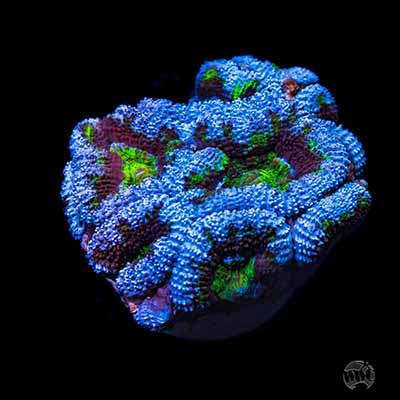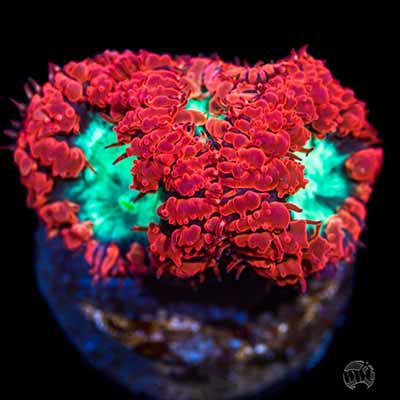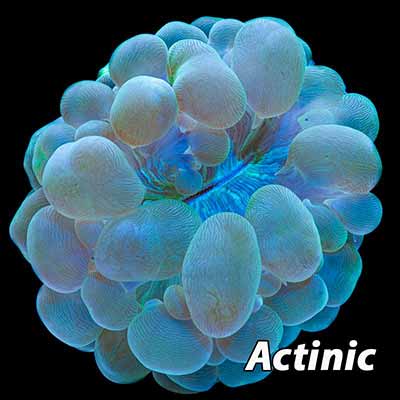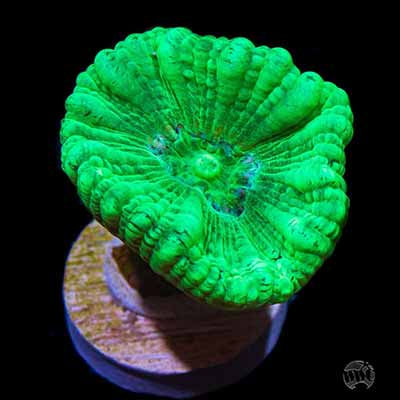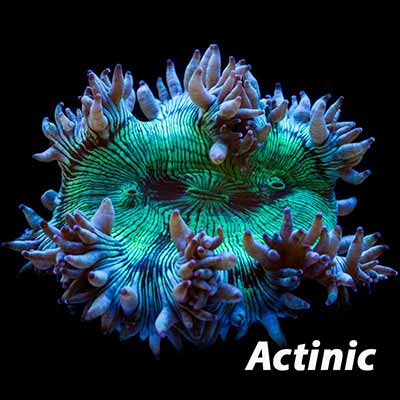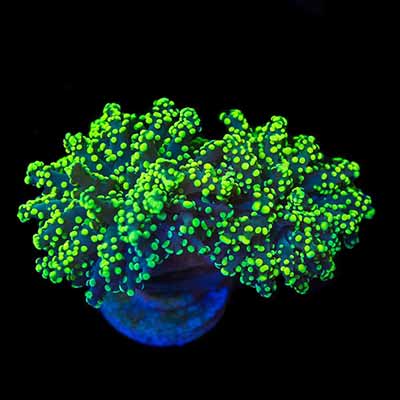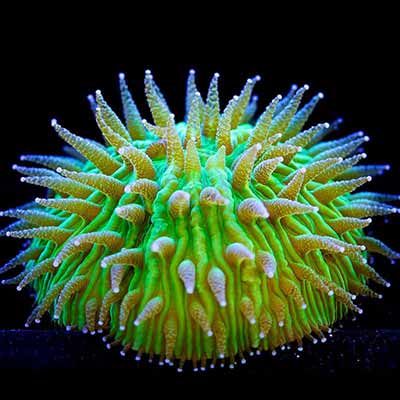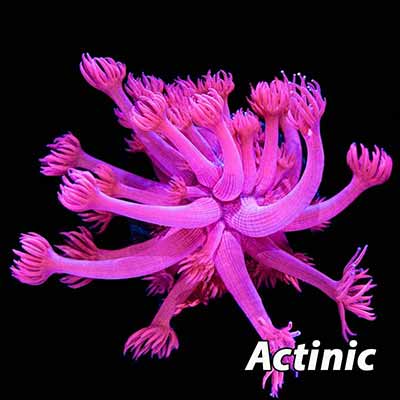Have you become interested in reef aquariums? Or perhaps you’ve already been working with soft corals and are interested in adding some hard corals to your reef tank. LPS corals are a great place to begin a reef aquarium. We’ve put together a guide with what you need to know to get started and keep your corals thriving.
What Are LPS Corals
LPS corals stand for large polyp stony corals. Stony corals mean the body of the coral is hard with a stony skeleton that is made from calcium carbonate. These corals also have large fleshy polyps. In appearance, LPS corals generally look like a cross between soft corals and SPS corals.
For those trying to decide between LPS or SPS corals, it is generally easier to keep LPS corals. Corals with smaller polyps can prove a greater challenge to feed than those with larger polyps. In fact, SPS corals require more careful monitoring of parameters and water quality in general. This makes LPS coral species a much better option for those starting out with a reef aquarium.
LPS or SPS Corals
One of the most important considerations is the fact that LPS corals are much better suited to beginners to reef aquariums. But it’s worth the time to get to know your corals, and here are some differences between the two:
- LPS Corals are More Aggressive: They possess sweeper tentacles, and they will attack those with nearby placement if given the opportunity.
LPS Coral Types
There are a wide variety of species of LPS corals, including:
LPS Coral Care
Because there are such a wide variety of species of large polyp stony corals, it can be detrimental to generalize too much about their care. But in general, LPS corals come from deeper waters. This means they are slower moving, with less light. As a result, LPS corals in a reef tank will generally require low to moderate light and water flow. LPS corals, with their large polyps, are capable of feeding directly on meaty foods. Although LPS corals are known as beginner coral, there are still many factors to constantly consider for those who keep LPS corals.
Water Parameters
Aim for a calcium level of 380-440, magnesium of 1300-1400, and alkalinity of 9-10. These numbers are all interconnected, a higher calcium reading will require you to keep higher magnesium and alkalinity. Nitrates and phosphates should be low, but not zero (2-5 and 0.01-0.06, respectively).
- Temperature: 76-80 Degrees Fahrenheit
- Salinity: 32-35 parts per thousand (ppt) / 1.024 – 1.028 sg (specific gravity)
- Nitrate: 2-5 (keep it low but not zero)
- Alkalinity: 9-10 (more is needed if there is a high calcium level)
- pH: 8.0-8.4
- Calcium: 380-440
- Magnesium: 1300-1400 (more is needed if there is a high calcium level)
Acclimation
In making certain your corals thrive, one of the most important steps is always going to be acclimation. How you introduce your new coral into the reef aquarium will greatly impact its future health. What is most important in considering proper acclimation is to carry out the process upon receipt of your new coral. It is a fairly simple process, but time is of the essence, as the coral will face a great deal of stress during transit.
- Turn the Aquarium Lighting Off: The coral has been in complete darkness, and it is important not to cause a shock to its system with heating from the light or over-lighting.
- Transfer the Coral to a Small Tub
- Add 1/2 cup of Aquarium Water Every Few Minutes
- Use an Optional Pest Control Dip
- Find the Right Tank Placement: Choose based on flow and low light to give the coral an opportunity to acclimate over the next few days. A quarantine system can be a great idea for introducing new corals into the display tank.
Growth Rate
The growth rate of LPS corals depends on several factors, including light, flow, and chemical stability. For LPS corals you want to aim for the light of PAR range 100-200. This is a moderate light environment. The flow you are looking for to promote growth in LPS corals is low to medium flow, around 10-15 times the aquarium volume. You also want to consider the placement of the flow. It should not be shooting directly at the coral but creating a flow that goes around the coral. One of the most important factors that will create a good growth rate is having stability in parameters. This is best achieved by regular and consistent tending.
Placement
There are several factors to consider when placing corals. Some species, such as certain brain corals, Scoly and Elegance, prefer to be placed on sand, while others should be placed on rocks. In general, an LPS coral can be placed wherever these preferences are met and the PAR lighting requirements are correct, keeping in mind that LPS corals do best with moderate to low lighting and moderate flow. But another important consideration is how aggressive the species is. Certain species, such as Chalice and Euphyllia, are especially aggressive and it is important to allow for proper spacing that accounts for long sweeper tentacles. To avoid these corals giving a sting to a neighbor, separate by 6 inches.
Another important aspect of placement involves the make-up of the entire tank. LPS corals have been known to eat fish, so it is important to add only reef-safe fish into your tanks. But these same reef tank fish can sometimes behave inconsistently and attack the coral, another thing to watch out for.
One last important note about placement. Corals should not be moved when they are inflated, especially species like hammer coral and bubble coral. Instead, splash water over them to encourage the coral to retract the fleshy polyp.
Flow Requirements
The truth is that there is quite a bit of variation amongst LPS species as to preferred flow. Commonly, Generally, Acans, Blastos, Bubble Corals, Cynarina, Donut Corals, Duncans, Elegance, and Fungia prefer low to moderate flow while Brain corals, Caulastrea, Chalice, Cup Corals, Euphyllia, Favia, Favite, Goniopora, and Scoly prefer moderate to high flow.
Lighting Requirements
Most LPS coral do best in a low to moderate light environment. This is because their natural habitat can be murky waters. Before venturing into the world of all the varieties of LPS coral it’s a good idea to acquire a PAR meter, either by renting or borrowing one from a local aquarium store and measuring your tank’s PAR so you can know exactly what corals your tank is best suited for. Low light is generally measured as less than 100 PAR, while moderate is around 100-300 PAR. Some species, like the Acan brain coral, can thrive at a much higher PAR, even up to 800.
Light Acclimation
Once you have a new coral, you can test its exact requirements by placing it half in the shade and half in the light. If it starts to turn neon, it is getting too much light, while turning brown is a sign of not enough.
A few pointers to acclimate your coral to your reef aquarium lighting is by lowering the overall daylight lighting. Ideally, lower it by 30% and then increase it back to normal by increasing it by 10% per week. Additionally, you can decrease the overall photoperiod of light in the beginning or even raise the entire light fixture.
Feeding
LPS corals appreciate meaty foods. While they can subsist on coral foods, liquid coral foods, and phytoplankton, they will do best when regularly being fed soft meaty foods. These include pellets, brine, krill, or mysis. The large fleshy polyps mean these corals are designed for eating larger foods. When they feed, tentacles will appear, and they will sometimes display these tentacles when hungry.
How Often Do you Feed LPS Corals?
The best way to find this out is by experimenting and getting to know your individual corals. Start out feeding small amounts once or twice a week and see how your coral responds. You’ll soon get to know how much and what your coral most likes to eat.
Best Time to Feed LPS Corals
Corals are alive and active at nighttime. This means the best time for feeding your coral is in the evening. While many people turn down the lights for feeding, it is also alright to keep them on and see what your corals are doing. Many turn off the circulation pumps so food does not get washed away from the coral, just be sure to turn it back on. Corals will become accustomed to your feeding schedule, so just be sure to keep it regular.
Why Are My LPS Corals Dying?
There are some specific threats to corals that you’ll need to watch out for in your reef aquarium.
LPS Coral Diseases
Rapid tissue loss (RTL) is one of the most common diseases faced by LPS corals. There are several additional coral diseases that can be mistaken for RTL:
- Black Band Disease: This causes complete tissue degradation brought on by a pathogenic microbial group. Advancement of the disease can be as severe as 1 cm during daylight hours.
- White Band and White Plague Disease: The pathogen is unknown for this disease, but it can be identified by a white band that starts at the base and increases as the disease progresses to the tip of the coral.
- Yellow Blotch Disease: Especially common to brain corals, it also affects other corals. This is marked by a patch of translucent yellow forming or a yellowish band at the base. The rest of the coral may appear healthy, but the patch will die, exposing skeleton and allowing algae to grow in the spot.
- White Spot or White Pox: White spots will come to appear on the coral’s surface. More will appear as the disease consumes the coral.
- Brown Lime or Brown Jelly Disease: This is especially common to LPS corals but can afflict all corals. It can be caused by physical damages or chemical imbalances in the water/ low water quality. The first sign is a brown filament which will eventually grow into a brown slime covering the coral.
With brown jelly disease there are some treatment options, but in general it is not possible to treat the coral. Rather it is important to remove the coral from the reef tank. At best, some healthy part of the coral may be fragged.
The best way to guard against disease is to prevent it in the first place. This is best accomplished by keeping the proper parameters (those closest to a coral’s natural habitat), and making certain they stay regular. It also means changing the water weekly and applying dips before adding a new coral to your reef tank.
Coral Pests
Unfortunately, pests can be a common occurrence in reef tanks. It’s important to be on the lookout in case you accidentally introduce any pests. A common cause of coral pests comes from frags, where people take a piece of coral and cultivate it to grow. They trade and sell these frags. Some of the pests that come with this to look out for include:
- Flatworms: The rust-brown flatworm and the Acropora eating flatworm both pose a danger to tanks. As their name suggests, the first is rust-colored and grow up to 1/4 inch in length. They have a red dot and will increase quickly in waters that have too high nutrient levels. At their height, they will actually land on coral, blocking light. Some think they even feed on the coral. The Acropora eating flatworm does eat coral and as such is far more aggressive than the rust brown flatworm, requiring immediate action.
- Snails: Box snails and pyramid snails can both pose a threat to corals.
In terms of treating flatworms, a freshwater dip can provide a great deal of protection, as flat worms are very sensitive to this. There are several fish species that you can introduce in order to control populations of flatworms. These include several species of Wrasse fish as well as Dragonets and the Blue Velvet Nudibranch. The last species is highly-effective, but short-lived in home aquariums.
For even the most delicate of corals it’s also possible to manually remove flatworms with a syringe without damaging the coral. Be sure to splash a cup of water over the coral to make certain the polyps retract.
For box snails, it is simple enough to remove the threat to the colony.
Coral Bleaching
This is its own kind of coral disease, and is unfortunately one of the most common. It occurs when the symbiotic algae, zooxanthellae is lost from the coral. This leads to the coral turning translucent as the flesh dies and the skeleton becomes apparent. The disease is very distinct because the flesh remains on the coral.
There is also such a thing as partial bleaching, where only part of the zooxanthellae is gone. This algae is responsible for the coral’s healthy color. If the loss is complete, the effect is nearly always fatal. If there is partial bleaching the coral is enormously susceptible to other diseases and is very vulnerable to changes in parameters.
The causes of bleaching include increases in lighting, extreme temperatures, extreme salinity and too high levels of water flow. Also if there are extreme changes in any of these categories or exposure to ultraviolet radiation, a coral could fall victim to bleaching. It can be hard to accurately diagnose the problem however because bleaching can also be a reaction to an infection from a pest.
If your coral is dying then it’s important to remember that any one factor in your reef tank could be contributing or causing their demise. This could include anything from the wrong alkalinity to the incorrect calcium level.
LPS Coral Tissue Recession
One sure sign that things are not right is if your LPS corals are experiencing tissue recession. If the root issue causing this problem is not addressed, the coral will likely die. Causes of tissue recession in corals include too high alkalinity, or any of the other parameters being incorrect. The water flow or the lighting could be wrong. Another factor that can cause tissue recession is not leaving enough space between around aggressive species. A regular sting can cause tissue recession.
Spawning
Spawning is how corals reproduce in nature. In the beginning, it was a rare occurrence, happening only in large aquariums sporadically. However, more recently, it has become much more common, and has even been known to happen in the reef tanks of hobbyists with some regularity. Some people even find the propagation of their coral problematic as it will take over the reef tank.
Are LPS Corals Hard to Keep?
LPS corals are known as good coral for beginners, but that doesn’t mean they are simple to keep. With all of the parameters needing to be kept just right with regular check-ups as well as numerous other factors affecting their survival, the care of LPS corals can be quite complex.
Another consideration is that many people do believe that soft corals are generally easier to keep than hard ones. While LPS are easier than SPS corals, soft ones might be the best choice for true beginners.
One of the reasons why LPS corals are easier than SPS corals is because the water where they live is naturally turgid and murky. This means that the reef tank requires a more affordable lighting setup. It is also much easier to maintain LPS corals over the long term. They are not as sensitive as SPS corals, and they don’t need as much in terms of water changes and temperature regulation. LPS coral is also much easier to grow.
Why Are LPS Corals Difficult?
One of the hardest parts of getting coral care right is the initial setup process. Each coral is different, as is each reef tank setup. Finding that sweet spot of what your corals need takes some time and experimentation. It is then important that you maintain exacting standards. While it is not necessary to be as precise with LPS as SPS corals, it still requires regular checking and maintenance. Also, remember that LPS corals need to be fed soft meaty food regularly to be at the peak of health.
LPS Corals for Beginners
When choosing LPS corals for beginners, it is best to stick with the hardiest species. Keep the following in mind when considering keeping LPS corals.
Great LPS Corals for Beginner:
- Bubble Coral
- Plerogyra
- Micromussa
- Euphyllia (Hammer, Frogspawn, and Torch)
- Acan
- Brain
Bubble coral or Plerogyra adds movement to a tank. It is important to give bubble coral plenty of space as they have long tentacles that can sting neighbors.
Micromussa that includes microlords and Aussie lords is a good beginner coral that comes in bright colors. It does need sufficient lighting.
Euphyllia require low flow and low lighting like bubble coral. Hammer coral is called such because of its hammer-shaped polyps. Frogspawn is one form of hammer coral and has the same requirements.
Acan is another great beginner coral.
Finally brain coral is a great choice, but it can be quite aggressive, so beware of fish.
What Is the Easiest LPS Coral to Keep?
One of the easiest corals to care for is the candy cane coral or Caulastrea furcata. The common name, candy cane, comes from the fact that they can come in red or brown with white stripes, like a candy cane. However, most candy cane corals are green with trumpet-shaped fleshy polyps. Another factor which makes them popular is their low price.
Are LPS Corals Aggressive?
Compared to other aquarium inhabitants, the answer is yes. With their tentacles, strong sting, and behavioral tendencies, LPS corals can be aggressive. This is dependent on species, however.
Are LPS Corals Filter Feeders?
Yes, unlike shallow-water corals, and like SPS corals, the LPS coral is a filter feeder. But with the large polyps, it can also digest larger food like shrimp, fish, krill, and phytoplankton.
In Conclusion on the Care of LPS Corals
For those interested in exploring the exciting world of stony corals, LPS corals are the place to start. Invest in a set-up that will allow you to achieve the parameters and conditions that your new LPS coral will need, and invest the time in maintaining and feeding regularly.
